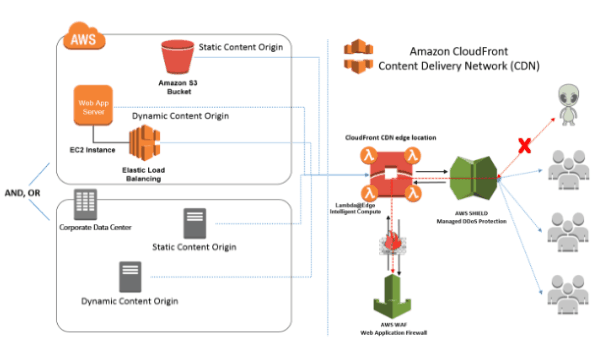Here in this post, we will talk about one of the best CDN for WordPress and which is “Amazon CloudFront“. If you are on this article, you probably already know what a CDN is. It stands for Content Delivery Network, and it distributes your content to different servers all over the world. This ensures that whenever someone requests your content, the content is served from a server nearest to that user. Apart from improving the performance of the website, another major benefit of CDN is that it reduces the bandwidth consumed by your website, as the bulk of the content is served via CDN.
Now, let’s see what Amazon CloudFront has in store for us.
Amazon CloudFront is a rock solid CDN that comes with a nice free option so that you can use this as free CDN for WordPress websites. Do note that the free plan is limited to 1 year of usage only. I have detailed other limitations of the free plan down below.

What I really like about this free CDN from Amazon is that it is built on Amazon’s rock solid infrastructure. The servers are truly distributed all over the world and can provide an instant performance boost to your website. And the performance of Amazon CloudFront is truly amazing.
We will mainly focus on the following parameters:
- Speed of this CDN.
- Available storage as well as bandwidth in free plan.
- Ease of integration with WordPress.
- Type of objects supported for CDN (images, JS, CSS, etc.).
To test this CDN for WordPress, I setup a sample WordPress site, and added close to 100 images in a single post, so that all the images are displayed together. I did not use any image optimization plugin, neither enabled lazy loading of images.
One thing that you might not like about Amazon CloudFront is that its not as easy to setup as some of the other free CDNs. But below I will give a few links that will make this process easy.
How to Integrate Amazon Cloudfront Free CDN with WordPress:
There are a couple of ways to integrate Amazon CloudFront with WordPress:
Step 1: To begin with, I will strongly suggest you start with this guide. It explains exactly how you can go about using Amazon CloudFront as free WordPress CDN. Essentially, you start by setting up a distribution in Amazon CloudFront, then add URL of your website to it so that it can pull all static resources from your website. The most complicated part is to make changes to WordPress website so that image URLs are replaced by URLs from Amazon CloudFront. The above article does a good job at describing the process for that too.

Step 2: In case you are looking for a plugin based solution, then you can try WP Offload S3 Lite. It uploads your images to Amazon S3 and then changes the URLs of images to that of images from Cloudfront. However, the free version of this plugin only works for new images that you upload, and not on the images that you already have. For uploading existing images also, you need to go with a paid version of the plugin, which starts from $59.
Step 3: Other plugins that you can use are WP Performance Pack and W3 Total Cache. In case of both these plugins, you will first setup Amazon Cloudfront as detailed in the article I linked above. After that, you can use these plugins to modify the path of the images, JS, CSS, etc. in your website.
So, there are multiple options you can use to integrate Free CDN from Amazon with your WordPress site.
Features of Free Plan of Amazon CloudFront:
Amazon Cloudfront free plan is a part of AWS Free tier. Here are the limitations of the free plan:
- Duration: The free plan of Amazon CloudFront is for 1 year only, and you need to pay after that. However, it is super cheap.
- Bandwidth: 50 GB per month
- Storage: 5 GB (in Amazon S3)
- Number of requests per month: 2,000,000 HTTP or HTTPS Requests
- Number of websites in free plan: Unlimited (the limits above are at account level, and not website level).
Also, do note that you need to provide your credit card information to sign up with Amazon CloudFront.
You may also like:
- How to Download Amazon Books as Free PDF, EBook
- How to Manage Multiple Clouds in One Place using MultCloud


